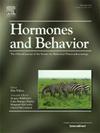Infanticide is driven by unfamiliarity with offspring location and associated with androgenic shifts in mimic poison frogs
IF 2.4
3区 医学
Q2 BEHAVIORAL SCIENCES
引用次数: 0
Abstract
Infanticide is widespread across the animal kingdom, but the physiological drivers of infanticide versus care or neglect are relatively unexplored. Here, we identified salient environmental and physiological antecedents of infanticide in the mimic poison frog (Ranitomeya imitator), a biparental amphibian. We explored potential environmental cues influencing infant-directed behavior by evaluating changes in the frequency of food provisioning and tadpole mortality after either cross-fostering tadpoles between family units or displacing tadpoles within the terraria of their parents. We found that changes in offspring location reduce care and increase infanticide. Specifically, parents fed their displaced offspring less and, in some instances, tadpole mortality increased. We also investigated whether care and infanticide were related to changes in steroid hormone concentrations in an unfamiliar setting. Infanticide of fertilized eggs and hatchlings in the new territory included cannibalism and was associated with lower testosterone concentrations, but not with changes in corticosterone. Overall, our results support earlier findings that familiarity with offspring location drives parental investment in poison frogs, while indicating an association between low androgen levels and infanticidal behavior in an amphibian.
模仿毒蛙的杀婴行为是由对后代位置的不熟悉引起的,并与雄性激素的变化有关。
杀婴现象在动物界非常普遍,但杀婴与照顾或忽视的生理驱动因素却相对缺乏研究。在这里,我们确定了模仿毒蛙(Ranitomeya imitator)这种双亲两栖动物杀婴行为的显著环境和生理前因。我们通过评估蝌蚪在家庭单位之间交叉寄养或蝌蚪在其父母的蛙舍内移位后食物供给频率和蝌蚪死亡率的变化,探索了影响婴幼儿行为的潜在环境线索。我们发现,后代位置的改变会减少对后代的照顾,增加杀婴行为。具体来说,亲本会减少喂养被转移的后代,在某些情况下,蝌蚪的死亡率会增加。我们还研究了在陌生环境中,照顾和杀婴是否与类固醇激素浓度的变化有关。在新环境中,受精卵和孵化幼体的杀婴行为包括食人,这与睾酮浓度降低有关,但与皮质酮的变化无关。总之,我们的研究结果支持了之前的发现,即对后代所在地的熟悉程度会推动毒蛙的亲本投资,同时也表明雄激素水平低与两栖动物的杀婴行为有关。
本文章由计算机程序翻译,如有差异,请以英文原文为准。
求助全文
约1分钟内获得全文
求助全文
来源期刊

Hormones and Behavior
医学-行为科学
CiteScore
6.70
自引率
8.60%
发文量
139
审稿时长
91 days
期刊介绍:
Hormones and Behavior publishes original research articles, reviews and special issues concerning hormone-brain-behavior relationships, broadly defined. The journal''s scope ranges from laboratory and field studies concerning neuroendocrine as well as endocrine mechanisms controlling the development or adult expression of behavior to studies concerning the environmental control and evolutionary significance of hormone-behavior relationships. The journal welcomes studies conducted on species ranging from invertebrates to mammals, including humans.
 求助内容:
求助内容: 应助结果提醒方式:
应助结果提醒方式:


